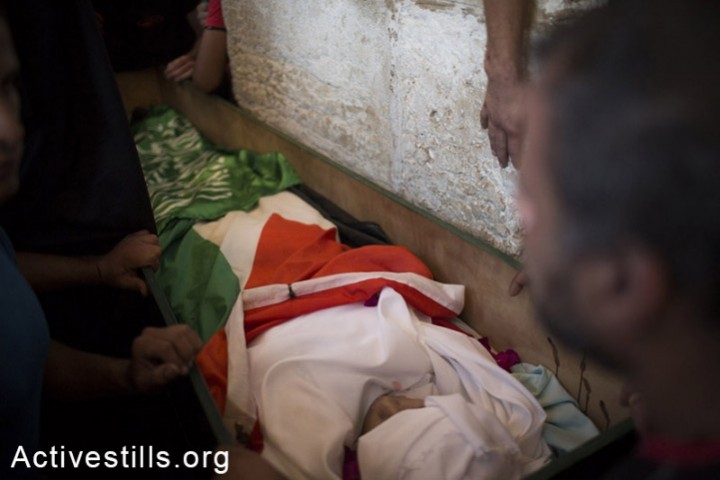Police originally said they had shot the teenager in the leg with a sponge-tipped bullet. Sixteen-year-old Mohammed Sunuqrut is the first Palestinian to die from the ‘less-lethal’ crowd control munition.

Sixteen-year-old Palestinian boy Mohammed Sunuqrut was shot in the head and not in the leg, as police claimed, leaked preliminary results of his autopsy showed. Israeli police shot Sunuqrut with a sponge-tipped bullet near a protest in East Jerusalem on August 31 and he died of his wounds a week later. The official autopsy report has not yet been published but both Israeli and Palestinian sources involved confirm that Sunuqrut died from a projectile wound to his head. The police claim — that they shot him in the leg as he threw stones and that when he turned to run, fell and cracked his skull — appears to be untrue.
Sunuqrut’s uncle Adel told +972’s Hebrew-language sister site, Local Call, that Mohammed was not protesting that day and claimed he had never taken part in any rioting or stone throwing. The teenager had been sent out to buy some bread, the uncle said, but 10 minutes after he left people came running to the home to say Mohammed was shot. Adel says that when he tried to reach his wounded nephew, Israeli policemen were surrounding the boy and wouldn’t let him through. He claims they threatened to shoot him if he didn’t back away, and continued to surround the boy for 10 to 15 minutes before allowing him to be evacuated to hospital.
Learn more about Israel’s use of crowd control weapons
What is even more disconcerting is that someone at the scene who identified himself as Ahmed made an emergency call to the Israeli emergency services dispatch describing Muhammed’s dire situation. He can be heard in the recording saying, “he was shot in the head, he’s unconscious,” Haaretz reported. Even if at that time police were convinced that Mohammed’s head injuries were caused by the fall, that does not explain why they delayed his evacuation to the hospital by so many crucial minutes. The bullet that hit Mohammed was also mysteriously missing from the scene.
Mohammed’s killing, which rekindled riots and clashes in East Jerusalem that have been taking place on and off all summer long since the murder of another teenage Palestinian resident of the area, Mohammed Abu Khdeir, marks the first known time a Palestinian has been killed by a sponge-tipped bullet. Because sponge-tipped bullets have never killed anyone in Israel or Palestine, the family originally claimed that Mohammed was shot by a rubber-coated steel bullet. Since October 2000, police have not been allowed to use rubber-coated bullets inside Israel (which includes annexed and occupied East Jerusalem where most Palestinians have residency status, not citizenship), but they continue to use the deadlier weapon against protesters in the West Bank. Apparently it is (more) OK to risk killing Palestinians — just not Israeli citizens or residents.
According to the Haaretz report, Israeli police recently introduced a new kind of sponge-tipped bullet that is heavier, larger and black in color instead of blue. They have reportedly been using it this summer in response to Palestinian protests and riots in East Jerusalem. Police claim they need them because the blue sponge-tipped bullets are not effective enough, according to the report.

But this new type of bullet, like the older one, may only be shot at the lower half of a person’s body; the projectile can indeed be fatal if shot at the torso or head, which is apparently what has just been demonstrated. Shooting above the waist is absolutely forbidden and those officers authorized to shoot the weapon at protesters undergo comprehensive training with it. So in addition to the police’s seemingly fallacious statement, it is unclear why Mohammed was shot in the head.
According to the report in Local Call, at least four other cases have been recorded this summer in which such projectiles were fired at the upper bodies of protesters and journalists. In July, Activestills and Walla! News photographer Tali Mayer was shot in the face and Activestills photographer Oren Ziv was hit in the arm.
This is far from the first time accounts relayed by Israeli authorities about the death of Palestinian protesters turned out to be false or at least misleading. In January 2011, the IDF kept offering new versions of events regarding the death of Jawaher Abu Rahmah, who died after inhaling large amounts of tear gas fired in Bil’in. On Nakba Day earlier this year, the IDF denied using live fire against two Palestinian teenagers shot while appearing to present no threat; an autopsy later showed that the boys were killed with live bullets.
Related:
Truth, tapes and two dead Palestinians
The IDF Spokeperson’s ever-changing story about Bil’in death


